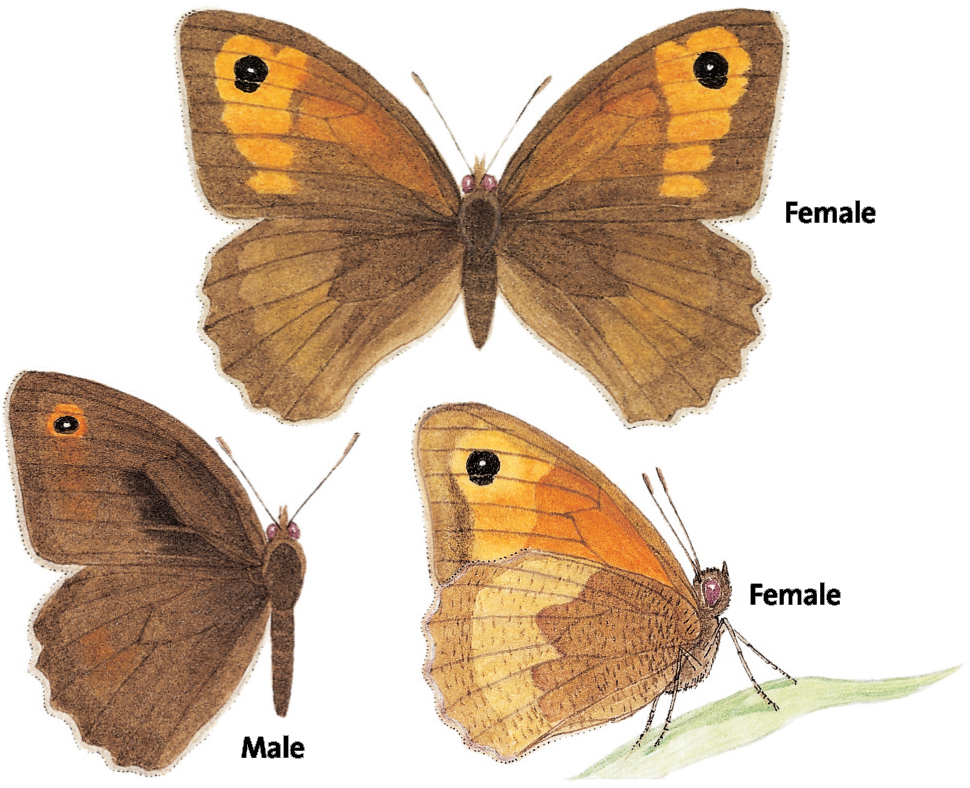
Marbled White
Melanargia galathea

SIZE AND DESCRIPTION
Forewing 23mm. Upperwing is yellowish-white with very heavy black markings. Underside is paler, hindwing being grey and white with small eyespots. Hind underwing of female has a marked yellow tinge, as does the leading edge of the forewing. Larva is pale green or pale brown.
HABITAT AND DISTRIBUTION
Grassy areas at up to 1,500m throughout the whole of western Europe, including southern England.
FOOD AND HABITS
Flies June–July. Larvae feed on grasses such as Cock’s-foot. Overwinters as a larva.
Grayling
Hipparchia semele

SIZE AND DESCRIPTION
Forewing 24mm. Upperside is brown washed with orange, with two small eyespots on the forewing and one on the hindwing. Underside has a pale orange forewing with two eyespots, and a mottled hindwing. Upper wings of female have broad yellow bands. Larva is pale cream with darker stripes.
HABITAT AND DISTRIBUTION
Heaths and rough grassland with bare ground patches for basking in sunshine. Subspecies occur throughout central and southern Europe; more coastal in Britain.
FOOD AND HABITS
Flies July–August. Larvae feed on grasses.
Mountain Ringlet
Erebia epiphron

SIZE AND DESCRIPTION
Forewing 19mm. Upperside velvety-brown with black-centred orange patches. Underside pale to deep brown with some orange on the forewing. Larva is small and green.
HABITAT AND DISTRIBUTION
Craggy slopes at high altitudes. Mountainous habitats in southern and central Europe, and northern Britain.
FOOD AND HABITS
Flies July–August. Larvae feed on grasses and hibernate.
Scotch Argus
Erebia aethiops

SIZE AND DESCRIPTION
Forewing 22mm. Upperside velvety-brown with an orange band containing white-centred eyespots. Underside similar to upperside, but the hindwing has 1–2 yellowish or silvery-grey bands, the outermost one with small eyespots. Female is generally paler than male. Larva is pale cream with pale and dark bands.
HABITAT AND DISTRIBUTION
Found mainly on high ground. Central Europe and extreme northern Britain.
FOOD AND HABITS
Flies July–September. Larvae feed on grasses and hibernate.
Meadow Brown
Maniola jurtina

SIZE AND DESCRIPTION
Forewing 25mm. There is much variation in colour and size. Male typically lacks orange on the upper wings, which is present in female. Upper wing has a single black eye with a white highlight. Larva is green with a white stripe along the sides.
HABITAT AND DISTRIBUTION
Grassland; also woodland in southern Europe. Very common across Europe southwards from southern Scandinavia at up to 2,000m.
FOOD AND HABITS
Flies May–September. Larvae feed on grasses. Overwinters as a larva.
Ringlet
Aphantopus hyperantus

SIZE AND DESCRIPTION
Forewing 22mm. Upperside is very dark brown-black, with small and rather indistinct eyespots. Underside is paler with clearer eyespots ringed with yellow. Female is slightly paler than male. Larva is pale cream with a lighter band along the sides.
HABITAT AND DISTRIBUTION
Woodland rides and clearings, and damp grassy areas at up to 1,500m in western Europe.
FOOD AND HABITS
Flies June–July. Larvae feed on grasses. Overwinters as a larva, then pupates on ground.
Gatekeeper
Pyronia tithonus

SIZE AND DESCRIPTION
Forewing 22mm. Usually smaller than Meadow Brown (Maniola jurtina), with orange patches on the wings. ‘Eyes’ are black with two highlights on each forewing. Male has a broad band of dark scent scales on each forewing, and a fuller orange colour than female, which is paler and larger. Larva is green or brown.
HABITAT AND DISTRIBUTION
Hedgerows and woodland margins. Southern Britain and Ireland, and south across rest of Europe.
FOOD AND HABITS
Flies July–September. Larvae feed on fine-leaved grasses. Adults are fond of Bramble blossoms and Wild Marjoram.
Large Heath
Coenonympha tullia

SIZE AND DESCRIPTION
Forewing 19mm. Upperside is dull grey-brown washed with orange; forewing has small eyespots and hindwing has several eyespots. Underside has golden-brown forewing, slightly darker hindwing and more distinctive eyespots. Female is usually slightly paler than male. Larva is green with yellow lines.
HABITAT AND DISTRIBUTION
Flat wet areas such as bogs and waterlogged peat mosses. Northern and eastern Europe.
FOOD AND HABITS
Flies June–early July. Larvae feed on Hare’s-tail.
Small Heath
Coenonympha pamphilius

SIZE AND DESCRIPTION
Forewing 16mm. Male is generally smaller and brighter than female. Colouration is highly variable. Upperside is orange-brown with very small dark ‘eyes’. Underside hindwing is greyish, and forewing has a distinctive spot. Larva is mainly green.
HABITAT AND DISTRIBUTION
Grassy places at up to 2,000m. Across Europe except northernmost Scandinavia.
FOOD AND HABITS
Flies April–October, in 1–3 broods. Pupa feeds on grasses. Overwinters as a larva.
Speckled Wood
Pararge aegeria

SIZE AND DESCRIPTION
Forewing 20mm. Yellow-and-brown or orange-and-brown wings. Orange-spotted form (P. a. insula) south-west Europe and Italy; cream-spotted form (P. a. tircis) elsewhere. Larva is mainly green and up to 27mm long.
HABITAT AND DISTRIBUTION
Woodland clearings, gardens and paths across Europe from southern Scandinavia.
FOOD AND HABITS
Flies March –October. Single-brooded in north. Larvae feed on grasses. Overwinters in both larval and pupal forms.
Wall Brown
Lasiommata megera

SIZE AND DESCRIPTION
Forewing 22mm. Brown-and-orange patterned with an ‘eye’ on the forewing. Male typically has an oblique line of scent scales on the forewing. Underside of the hindwing is pale silvery-brown. Female is lighter and brighter than male. Larva is green.
HABITAT AND DISTRIBUTION
Rough grassy places and gardens. Britain (except northern Scotland) and across from southern Europe.
FOOD/HABITS
Flies March–October, in 2–3 broods. Adults sunbathe on walls and fences. Larvae feed on grasses. Overwinters as a larva.